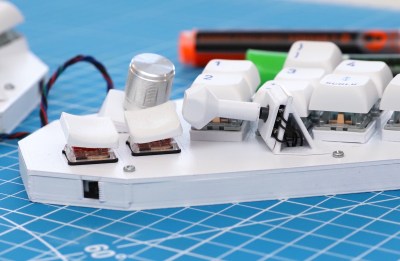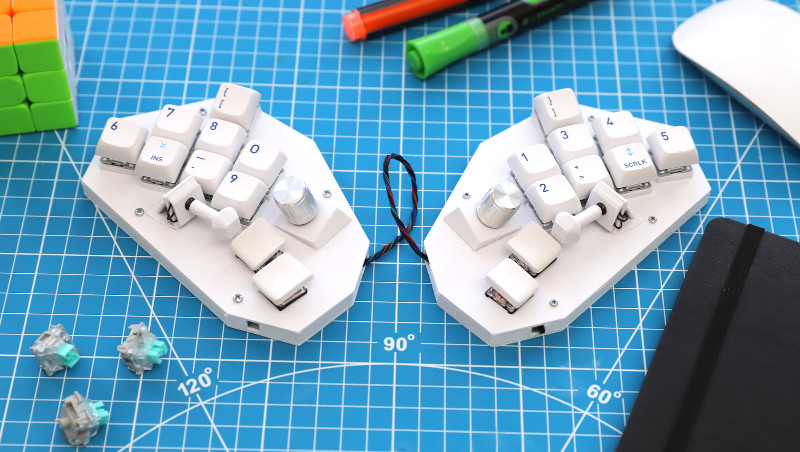It turns out that typing all day just might be bad for your hands and fingers. Repetitive Strain Injury, RSI, was a real problem for [David Schiller], particularly when coding. So, naturally, he started designing his own keyboard. And bless him, he’s shared the whole project on GitHub.
 The solution is Fulcrum, a chording keyboard with keys that can be pressed with minimal movement. And one more clever trick is a thumb joystick, mounted in the thumb’s opposable orientation. It’s a 5-way switch, making for a bunch of combinations. The base model is a 20-key arrangement, and he’s also designed a larger, 40-key option.
The solution is Fulcrum, a chording keyboard with keys that can be pressed with minimal movement. And one more clever trick is a thumb joystick, mounted in the thumb’s opposable orientation. It’s a 5-way switch, making for a bunch of combinations. The base model is a 20-key arrangement, and he’s also designed a larger, 40-key option.
The build is pretty simple, if you have access to a 3D printer. Print the STLs, add key switches, and wire it all up to a microcontroller. Use the supplied code, and all that’s left is to learn all the chord combos. And why stop with combos for single characters, when there are plenty of common words and plenty of key combinations. If you decide to build your own take on the Fulcrum, be sure to let us know about it!















Fulcrum Fights Finger Fatigue
If you want to reduce RSI from coding then just get a subscription to GitHub Copilot. There is no sense in typing every character with your own hands when you can just prompt a machine to do it for you.
Work smarter, not harder.
The problem with copilot is the lack of attribution to code. And even then, AI has been shown to spit out exact replicas of training data (source: look on vice.com).
There is a lawsuit against github for the exact reason.
Also: What do you do if you can’t benefit from copilot? Such as 911 responders, they can’t use that, and they have to be able to type at 100+ WPM.
There is another problem with copilot as well – it might spout a working code that meets your description, however it can not write that code in the right way for your project. Not every project wants that problem solved that way.
From having used copilot for most of the past year, it is like a Jr programmer that reads stack overflow at times. However, I’ve learned how to tell it what to do and get code that is indistinguishable from what I would write just like the code I get when I train a Jr programmer to write good code.
This BS that copilot regurgitates GitHub code shows a fundamental lack of understanding of how machine learning works and generates results. Just like my learned ability to tell copilot how to generate code like mine, it is possible to tell copilot how to generate code that looks like someone’s code or solution.
I have one of IBM’s one-handed cord keyboards sitting on my shelves — the one with the dimples key tops to provide tactile feedback for chord positions. I have never gotten around to digging out the intended encodings, so I’ve never had it hooked up and running on my own PC.
Chord, not cord. Darned auto-incorrect.
Achording to you.
B^)
I’ve never even seen a high-quality _picture_ of that IBM dimple chording keyboard, everyone just reproduces ever more degraded copies of the grainy black-and-white image from the original paper (Nathaniel Rochester, Frank C. Bequaert, Elmer M. Sharp. (December 1978). “The Chord Keyboard”. IEEE Computer.).
That paper is a neat read if you’re in to exotic keyboards, and has enough detail to think seriously about trying to build a repro. I don’t think you’ll be connecting an original (designed to connect to a modified IBM Model 1130) to anything modern without a pretty substantial embedded project, but it would be amazing if you could document yours.
Any chance of getting some pictures? As the other person said, there aren’t many good pictures of them online.